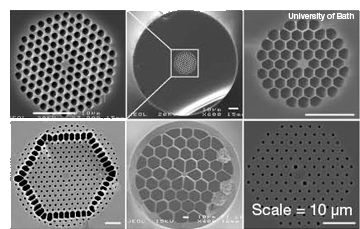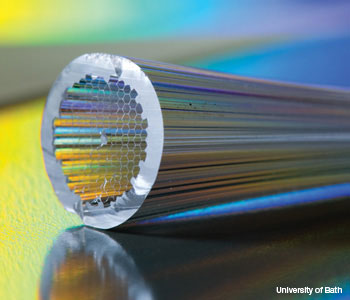 Photonic crystal fiber preform.
Photonic crystal fiber preform.
University of Bath
Photonic crystal fiber (PCF) research began with pioneering experiments that demonstrated light guided by PCFs, first by total internal reflection and then by photonic bandgaps. Now that the basics of the field have been well defined, experts are focusing their research on developing and fine-tuning PCF applications.
We have worked with silica glass PCFs for more than 10 years. During that time, we have seen an amazing array of intricate glass structures produced in our laboratory and elsewhere. Silica is commonly used in fiber optics research because it is highly transparent and it is available with exceptional purity by chemical vapor deposition processes.
Silica is not just a glass with excellent optical properties; it also has outstanding physical properties. It is close to an ideal glass and allows for drawing fibers over a wide range of processing temperatures. Since it does not crystallize easily, researchers can choose from many viscosities without having to set the temperature precisely. This is very important when one is trying to maintain a particular pattern of small holes or thin strands of glass against the disruptive forces of surface tension. With such a versatile material to work with, our question is almost always “What shall we make?” rather than “What can we make?”
PCF technology allows for fundamental changes in the way light is generated, delivered and used—but it is still a small-volume, handmade optical fiber. In order for applications of PCF to last, researchers need to find applications that are beyond the capabilities of even bespoke specialty fibers of conventional designs.
Continuum generation and four-wave mixing
The first widespread PCF application was the nonlinear generation of a visible and UV supercontinuum in a single transverse mode. Engineered PCF-based light sources have been commercially available since 2005.
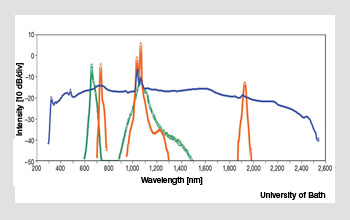 Continuum generation and four-wave mixing. Comparison of a supercontinuum (blue line) with four-wave mixing (FWM) (orange and green lines). The continuum spans the entire UV-visible-NIR with a smooth spectrum and a relatively low spectral power density. FWM in two different photonic crystal fibers generates high-power density at specific wavelengths for applications such as STED microscopy.
Continuum generation and four-wave mixing. Comparison of a supercontinuum (blue line) with four-wave mixing (FWM) (orange and green lines). The continuum spans the entire UV-visible-NIR with a smooth spectrum and a relatively low spectral power density. FWM in two different photonic crystal fibers generates high-power density at specific wavelengths for applications such as STED microscopy.
University of Bath
A white light supercontinuum source delivers the direction and focus of a laser beam while providing all wavelengths of light. This technology has the potential to change the way we observe and characterize a range of systems. For example, a supercontinuum can replace an array of different wavelength lasers in a confocal microscope or a flow cytometry system, allowing arbitrary selection of the excitation wavelength at any time. In optical fiber testing, a supercontinuum gives the brightness needed to perform any required diagnostic test—mode profile, attenuation or dispersion—at any wavelength and without high sensitivity detectors. A supercontinuum is usually pulsed and therefore suitable for fluorescence lifetime spectroscopy and imaging, while once again allowing on-the-fly selection of the excitation wavelength.
Before PCFs, it was very expensive to use continuum technology in research. Researchers could generate a supercontinuum in glass and sapphire plates, but it required a high-energy amplified femtosecond laser system. Supercontinua were, and still are, also produced in conventional fibers pumped close to their zero-dispersion wavelengths of 1,300 nm or longer. However, these fiber continua do not extend far into the visible spectra of light—which restricts their applicability in many fields, particularly microscopy.
PCF supercontinuum generation originated with experiments at Lucent Technologies in 1999—a breakthrough that spurred a frenzy of interest in the years that followed. The large refractive index contrast in a PCF not only enabled the light to be concentrated into a smaller core, but also allowed much shorter zero-dispersion wavelengths in a single-mode fiber. This discovery proved that an unamplified femtosecond laser at 800 nm was enough to pump the source, broadening the reach of supercontinua among research laboratories with existing laser systems. Nevertheless, the pump laser was still discouragingly sophisticated and expensive.
Laser trade shows at that time revealed to us that the simplest way of achieving pulsed lasers with a peak power in the kW range and a pulse energy of less than a micro-joule (so as not to damage the fiber) was the Q-switched 1,064-nm microchip laser. The process for developing a PCF suitable for pumping at this wavelength was straightforward, and it made low-cost supercontinuum sources available to many more laboratories. Despite the longer pump wavelength, the continua from these PCFs extend into the visible.
This type of supercontinuum source is now an essential tool in our laboratory. It is easy to forget that just a few years ago, some of our current experiments would have been very, very slow or even impossible. A striking example is the broad bandwidth interferometry of fiber modes through the visible and near-infrared range of light: The source has sufficient signal to not only measure the mode group indices but also to observe the guided mode patterns and unambiguously assign the measured group index to a particular spatial mode.
Additionally, the broad spectrum means that a single source operates over the entire transparency range of silica fibers, from below 400 nm to beyond 2,400 nm. Therefore, once suitable PCFs became available, commercial supercontinuum sources based on picosecond Yb3+-doped fiber lasers arrived on the market without delay. Supercontinua have also been demonstrated with continuous wave fiber lasers at powers of 10 to 100 W over long fiber lengths.
We have endeavored to tailor supercontinua and related sources to match demanding applications requiring higher spectral power density, power focused in a particular spectral region or longer or shorter wavelengths.
By fabricating a PCF that tapers linearly from a core diameter of about 4 to 2 µm over a few meters of fiber, we have been able to generate deep UV light with wavelengths as short as 310 nm. These tapers are drawn automatically and continuously on the drawing tower. Individual fibers can then be cut from the continuous spool.
|
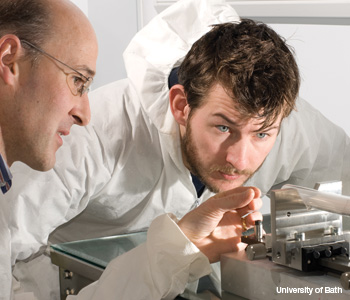 William Wadsworth (left) and Sam Bateman finish a photonic crystal fiber stack.
William Wadsworth (left) and Sam Bateman finish a photonic crystal fiber stack.
University of Bath
Supercontinua generated from picosecond-pulsed fiber lasers typically arise from the break up of high-order solitons in the PCF, which can cause a 20 percent pulse-to-pulse amplitude noise for a particular wavelength component. This fluctuation is not always a problem; it can actually be an advantage. Different pulses produce various spectra, which yield a very smooth average spectrum. The average is rapidly reached—the noise is truly random, so it is reduced by √N for N pulses. With a typical pulse repetition frequency of tens of megahertz, integration for just 100 µs averages out the noise over 1,000 pulses. Most applications treat a pulsed supercontinuum as a quasi-continuous wave source and are able to take advantage of the smooth and broad spectrum.
However, there are other applications where pulsed sources with low pulse-to-pulse noise are important. For example, point-by-point imaging and microscopy techniques require one pulse per voxel for fast 3-D acquisition. We have addressed this by generating a supercontinuum in fibers with normal dispersion; this avoids the high-order soliton breakup that introduces noise.
PCF can provide the necessary normal dispersion at Yb3+-doped fiber laser wavelengths. This continuum has reduced spectral coverage, but its amplitude noise is decreased to the level of the pump laser. It is possible to generate broadband spectra simultaneously with low noise for short fibers with pulses of short duration, about 30 fs or less at 800 nm. Such fibers were used for early work on femtosecond laser pulse stabilization and absolute frequency metrology, although advances in broadband femtosecond oscillators often eliminate the need for further broadening in fibers for that application.
Four-wave mixing (FWM) is a nonlinear process closely related to supercontinuum generation. FWM occurs when two identical pump photons are annihilated to produce two new photons with different wavelengths and the same total energy. Researchers have extensively studied FWM phase-matched by optical fiber dispersion in conventional fibers at telecommunications wavelengths around 1,550 nm.
Once again, PCF is able to provide the necessary dispersion for pumping with shorter-wavelength picosecond and nanosecond Nd3+- and Yb3+-based lasers to produce output wavelengths from 660 nm upwards. Conversion efficiencies are 10 to 30 percent for a single pass along a few meters of the appropriate PCF. Because FWM converts to a pair of discrete wavelengths rather than a broad continuum, it can deliver a much higher spectral power density at a specific target wavelength.
Whereas a high-power supercontinuum may generate a few mW/nm in the visible spectrum, FWM is capable of delivering more than 2 W in a 10 to 20 nm band. One can easily achieve significantly reduced bandwidth and a higher spectral power density by seeding one of the output wavelengths with a tunable, narrow-band continuous wave laser. This can be deployed for further frequency conversion into the visible.
At the opposite end of the power scale, FWM can be used as a high-fidelity source of heralded single photons for quantum information processing because it creates output photons in pairs. Pumping with a low-power picosecond fiber laser at 1,064 nm yields single photons at telecommunications wavelengths, heralded by the detection of their paired photons close to 800 nm. Careful control of the phase matching, including birefringent terms, can also help to generate the single photons in narrow-band pure states.
Hollow-core PCFs
When Philip Russell proposed the idea for PCF in 1992, his exciting plan was to construct a fiber with a photonic bandgap, which would make it possible to fabricate a fiber with a hollow core (HC PCF). This dream was realized in 1999. Since then, we have worked with colleagues to demonstrate transmission losses as low as 1.2 dB/km at 1,620 nm and transmission windows centered at wavelengths between 500 and 3,600 nm. HC PCFs enable high-energy pulse transmission with low nonlinearity and dispersion. Pulse delivery with durations of about 300 fs and energies of 60 nJ at 800 nm and more than 200 nJ at 1,064 nm (sufficient for many laser micromachining applications) are not possible in conventional fibers, but have been achieved via fundamental solitons in HC PCFs. Researchers have also demonstrated the transmission of nanosecond pulses with energies as high as 0.5 mJ.
Both low-energy linear pulse propagation and soliton propagation in HC PCFs are very promising for the delivery of high-quality pump pulses for nonlinear spectroscopy, microscopy and endoscopy—for example, coherent anti-Stokes Raman scattering, two-photon fluorescence and second- or third-harmonic generation processes. We have created HC PCFs with a built-in high-NA annular return path for the signal light and multicore HC PCFs for multiple point sampling by using the design and fabrication flexibility of PCF.
While bandgap-guiding HC PCF technology is of fundamental scientific interest and provides small-core fibers with a very low-loss hollow waveguide, it has a limited transmission window of up to 25 percent of the central frequency. There are applications where a broader transmission window is required and a higher attenuation is tolerable, while a larger hollow core may be sufficient or even desirable—for example in broadband nonlinear wavelength conversion through the Raman effect in gases or in very high power laser transmission.
Some scientists have suggested that controlling the shape of the glass webs that form the core boundary is enough to satisfy these requirements, while the detailed structure of the cladding may not matter at all. Evgueni Dianov’s group recently presented a HC PCF that is essentially reduced to this core boundary. The demonstrated loss was well below 1 dB/m for several bands spanning to beyond 3.5 µm, despite the immense attenuation of silica glass at that wavelength. This is a remarkable performance for such a simple structure. Its simplicity has allowed Dianov’s group to make a similar fiber from chalcogenide glass for transmission of CO2 laser radiation at 10.6 µm.
|
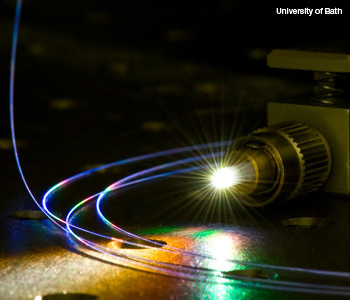 White light supercontinuum.
White light supercontinuum.
University of Bath
Control of losses in PCF
As PCF has moved from a purely research endeavor to more practical applications, reducing fiber loss has become of great importance. Beyond the expected intrinsic attenuation of high-purity silica glass, such loss has two main causes. First, the processing involved in PCF fabrication causes loss from the extrinsic absorption of contaminants introduced to the glass and from structural defects in the glass matrix. Second, scattering from surface roughness at the air-hole boundaries is strong because of the high index contrast. The scattering is particularly pronounced if the guided mode intensity is high at the boundaries—for example, in PCFs with core diameters less than 2 µm. Scattering is also the major source of attenuation in HC PCFs.
Unfortunately, scattering that arises from frozen-in surface capillary waves that are thermally excited at elevated temperatures in the furnace is unavoidable. However, the extrinsic absorption from impurities and structural defects is potentially amenable to reduction. We have recently made significant progress on reducing fiber loss from these sources.
Our PCF starting material is a synthetic silica glass (Suprasil F300 from Heraeus). The only impurity in the glass that causes measurable attenuation is the hydroxyl group (OH), at a level of about 0.2 ppm, corresponding to about 12 dB/km of absorption loss at 1,384 nm. The first step to making PCF is to draw thin capillary tubes and rods before stacking them by hand. The tubes and rods are then redrawn in two stages to the final fiber diameter, all in a low-purity (class 10,000) cleanroom without humidity control. Surprisingly, despite the many processing steps, including those in which the glass in and around the core is handled, there is no measurable attenuation introduced from additional impurities other than an increase in OH.
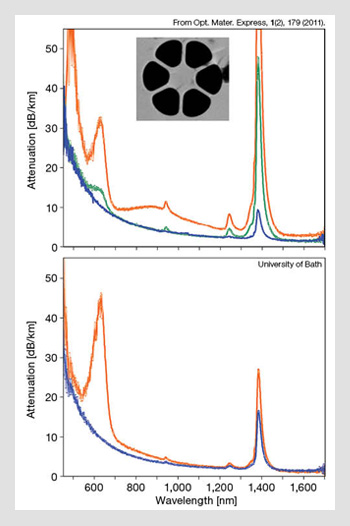 Control of losses in photonic crystal fibers. Spectral attenuation for fibers with the same structure (inset) but different processing. (Left) Three fibers drawn with different delay between preform and fiber drawing stages: blue, 3 hrs; green, 18 hrs; orange, 7 days. (Right) Two fibers drawn after a long delay: orange, no further processing; blue, preform annealed before drawing fiber. The plots show that attenuation at 1,384 nm due to OH rapidly increases with time. Absorption bands at 630 nm and 900 nm due to structural defects in the glass also appear. OH is considerably reduced, and defects are removed by annealing prior to the final fiber draw.
Control of losses in photonic crystal fibers. Spectral attenuation for fibers with the same structure (inset) but different processing. (Left) Three fibers drawn with different delay between preform and fiber drawing stages: blue, 3 hrs; green, 18 hrs; orange, 7 days. (Right) Two fibers drawn after a long delay: orange, no further processing; blue, preform annealed before drawing fiber. The plots show that attenuation at 1,384 nm due to OH rapidly increases with time. Absorption bands at 630 nm and 900 nm due to structural defects in the glass also appear. OH is considerably reduced, and defects are removed by annealing prior to the final fiber draw.
(Top) From Opt. Mater. Express, 1(2), 179 (2011). (Bottom) University of Bath.
The greatest factor in OH introduction is time, with rapidly fabricated fibers (within three hours of stacking) having an attenuation close to the original stock glass (8 dB/km at 1,384 nm and about 1 dB/km at 1,500 nm for fibers with 5 µm diameter core). Delays of hours or days rapidly increase the OH content and associated absorption. They also greatly increase attenuation bands at other wavelengths, which are attributed to drawing-induced structural defects in the silica glass.
Nevertheless, low-loss fibers may be drawn from preforms that have been stored if the preform is annealed immediately prior to the final fiber drawing. This annealing is performed at around 1,880 °C with flowing nitrogen in the preform holes. Each portion of the preform is annealed for three to five minutes as it passes through the furnace. Fibers drawn from annealed preforms have low attenuation, which we attribute to removal of water adsorbed to the preform surface and to relaxation of any stresses frozen into the preform when it was drawn from the initial stack. Reducing the OH content of PCFs without chemical dehydration or etching steps is a significant simplification in the fabrication process required to achieve low-loss fibers.
PCFs with small cores are particularly sensitive to attenuation due to surface roughness. Additionally, there is a rapid increase of fiber loss due to OH for smaller cores, even with preform annealing. A fiber with a 5 µm core diameter may have an attenuation of 10 dB/km at 1,384 nm. The attenuation rises rapidly for cores less than 2 µm diameter—to 65 dB/km and 105 dB/km for 1.5 and 1.2 µm diameter cores, respectively.
A bright start, a healthy future
PCFs were rocketed to prominence by the technological and visual appeal of bright supercontinuum light. A burgeoning worldwide collection of peer-reviewed literature indicates that there is broad interest in the application of PCFs in science, technology and medicine.
It is in the field of medicine that PCF may make its next big step. We have been approached to develop the work described in this article in various near-clinical settings, which has led to several current and planned collaborative projects. Innovative technologies are needed to meet today’s health care challenges, and PCFs are ready to make some of the breakthroughs.
William Wadsworth, Jonathan Knight and Tim Birks are from the Centre for Photonics and Photonic Materials, department of physics at the University of Bath, United Kingdom.
References and Resources
>> K. Saitoh and M. Koshiba. "Empirical relations for simple design of photonic crystal fibers," Opt. Express 13(1), 267-74 (2005).
>> P. St. J. Russell. "Photonic-crystal fibers," J. Lightwave Technol. 24(12), 4729-49 (2006).
>> J. Fulconis et al."Nonclassical interference and entanglement generation using a photonic crystal fiber pair photon source," Phys. Rev. Lett. 99(12), 120501 (2007).
>> J.M. Dudley and J.R. Taylor, eds. Supercontinuum Generation in Optical Fibers, Cambridge University Press (2010).
>> L. Lavoute et al. "High power red and near-IR generation using four wave mixing in all integrated fiber laser systems," Opt. Express 18, 16193-205 (2010).
>> A.M. Heidt. "Pulse preserving flat-top supercontinuum generation in all-normal dispersion photonic crystal fibers," J. Opt. Soc. Am. B 27(3), 550-9 (2010).
>> S. Brustlein et al. "Double-clad hollow core photonic crystal fiber for coherent Raman endoscope," Opt. Express 19(13), 12562-8 (2011).
>> A.D. Pryamikov et al. "Demonstration of a waveguide regime for a silica hollow-core microstructured optical fiber with a negative curvature of the core boundary in the spectral region > 3.5 µm," Opt. Express 19(2), 1441-8 (2011).
>> I. Gris-Sánchez et al."Reducing spectral attenuation in small-core photonic crystal fibers," Opt. Mater. Express, 1(2), 179-84 (2011).

